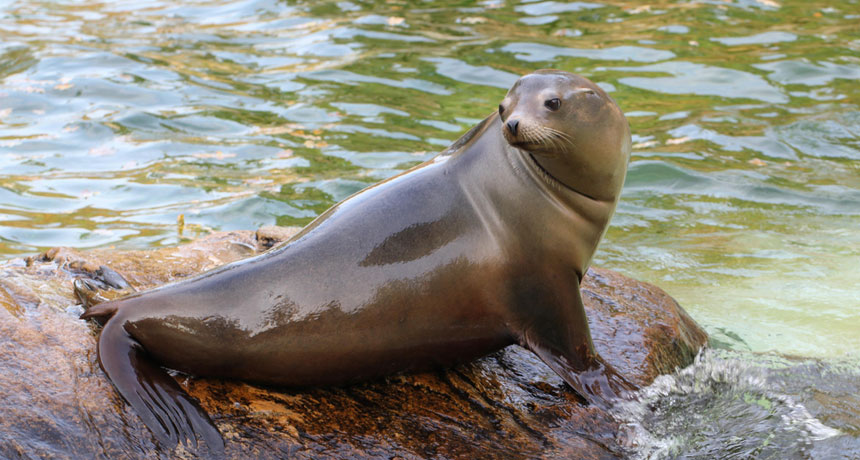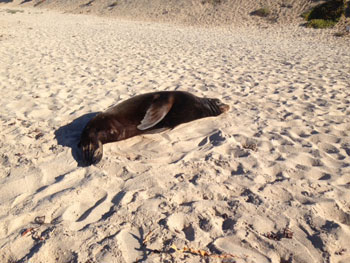Algal poison can harm sea lion memory
Scientists trace memory problems to blooms of toxic algae

Sea lions, like this California denizen,can get become poisoned by eating fish laced with an algal poison. The toxin causes seizures and brain damage. These can harm this mammal’s spatial memory, a new study finds.
Ruben Undheim/ Flickr (CC BY-SA 2.0)
SAN FRANCISCO, Calif. — There is no locally caught crab on the menu here. The state of California warned earlier this year that these crustaceans should not be eaten. The reason? They may have high levels of a powerful chemical that poisons the nervous system. It can lead to death, even in people. Certain algae make this toxin. And there’s been a huge bloom of them off of the state’s coast this year.
Unfortunately, sea lions can’t read the warning notices. The toxin accumulates in organisms that eat the algae. And some of those creatures (or the fish that eat them) can serve as a sea lion’s lunch. When that happens, these marine mammals may be poisoned. A new study has now helped identify how that poisoning affects a sea lion’s brain.
Since 1998, California sea lions have been washing up along the Pacific Coast during algal blooms. They often show seizures and signs of confusion. Both are symptoms of poisoning by the algae’s toxin: domoic (Dah-MO-ik) acid.
Scientists know that domoic acid can alter the sea lions’ hippocampus. This is a part of the brain important to memory. The toxin, here, can cause seizures, which then cause brain damage. Now researchers have evidence that this brain damage impairs the animals’ spatial memory. This is the type of memory that helps an animal understand where it is. It not only helps a sea lion find food, but also navigate in the ocean. There are also signs that there could be even more widespread harm to brain function, says Peter Cook. He was reporting new data, here, this week at the Society for Marine Mammalogy Conference. Cook is a neuroscientist at Emory University in Atlanta. He led the new study.

The first test used a simple maze. In it, an animal had to make one choice: Go right — or left. Food is alternately placed on the left and the right. A sea lion, healthy or not, quickly learns this simple pattern, easily finding food again and again. A healthy sea lion will follow the pattern even if there is a small delay — say, a researcher puts a board at the front of the maze for seven seconds. But sea lions that had damage in the right hippocampus had trouble remembering the pattern and finding the fish.
In the second test, each day a sea lion was presented with four buckets placed at separate locations. One bucket always had fish. Animals tend to find the fish faster every day, eventually learning that one bucket always has the food. But again, sea lions with damage to their right hippocampus weren’t as good at this task.
“The guys with the hippocampal damage were really lost at sea,” Cook said. The animals’ spatial memory was impaired.
This brain damage could make it hard for the animals to navigate and find food in the wild. This would explain why some sea lions become stranded on land and others veer off in odd patterns in the ocean, he said. Cook and his colleagues will report their findings in the December 18 Science.
Problem may be bigger than this
In people, the right hippocampus is involved in spatial memory and the left is needed for verbal memory. Scientists aren’t quite sure, however, what the left hippocampus does in sea lions, Cook says. Indeed, damage to the left hippocampus didn’t seem to have any effect on the sea lions’ performance — at least not in the spatial tests.
But the algal toxin’s damage may go beyond spatial memory. In healthy sea lions, brain scans showed that the hippocampus “talked” with the thalamus. That second part of the brain is involved in sensory processes and movements. In the animals exposed to domoic acid, “the hippocampus and the thalamus are not talking to each other,” Cook reports. That could be a sign that there are more widescale problems in brain function.
Blooms of the algae that cause domoic-acid poisoning occur naturally off the California coast in spring and fall. However, “the blooms are getting bigger,” said Kathi Lefebvre. A marine biologist at NOAA’s Northwest Fisheries Science Center in Seattle, Wash., she was not involved in the new study. Lefebvre has studied domoic acid in sea lions, however. With ocean waters warming and sea ice disappearing, these toxic algal blooms are moving farther north, she notes. It seems linked to the warming waters, she says.
Scientists had never seen a sea lion with domoic acid-related seizures outside of California. Until this year. One showed up in Washington state, Lefebvre said. And there is concern that many other animals there might be affected, too, including birds and whales — even people. Commercially caught fish are tested for the toxin, so seafood bought in a shop or restaurant should be safe. But she notes that people might become exposed if they eat fish or other seafood that they catch themselves.
Power Words
(for more about Power Words, click here)
algae Single-celled organisms, once considered plants (they aren’t). As aquatic organisms, they grow in water. Like green plants, they depend on sunlight to make their food.
bloom (in microbiology) The rapid and largely uncontrolled growth of a species, such as algae in waterways enriched with nutrients.
crustaceans Hard-shelled water-dwelling animals including lobsters, crabs and shrimp.
domoic acid A toxin produced by some algae. If ingested by humans or other animals, it can cause brain damage, seizures and memory problems.
hippocampus A seahorse-shaped region of the brain. It is thought to be the center of emotion, memory and the involuntary nervous system.
magnetic resonance imaging (MRI) An imaging technique to visualize soft, internal organs, like the brain, muscles, heart and cancerous tumors. MRI uses strong magnetic fields to record the activity of individual atoms.
marine Having to do with the ocean world or environment.
marine biologist A scientist who studies creatures that live in ocean water, from bacteria and shellfish to kelp and whales.
National Oceanic and Atmospheric Administration, or NOAA A science agency of the U.S. Department of Commerce. Initially established in 1807 under another name (The Survey of the Coast), this agency focuses on understanding and preserving ocean resources, including fisheries, protecting marine mammals (from seals to whales), studying the seafloor and probing the upper atmosphere.
neuro An adjective that refers to neurons, the impulse-conducting cells that make up the brain, spinal column and nervous system.
neuroscience Science that deals with the structure or function of the brain and other parts of the nervous system. Researchers in this field are known as neuroscientists.
organism Any living thing, from elephants and plants to bacteria and other types of single-celled life.
psychology The study of the human mind, especially in relation to actions and behavior. To do this, some perform research using animals. Scientists and mental-health professionals who work in this field are known as psychologists.
seizure A sudden surge of electrical activity within the brain. Seizures are often a symptom of epilepsy and may cause dramatic spasming of muscles.
thalamus A part of the brain important for sensory and motor processes.
toxin A poison produced by living organisms, such as germs, bees, spiders, poison ivy and snakes.







